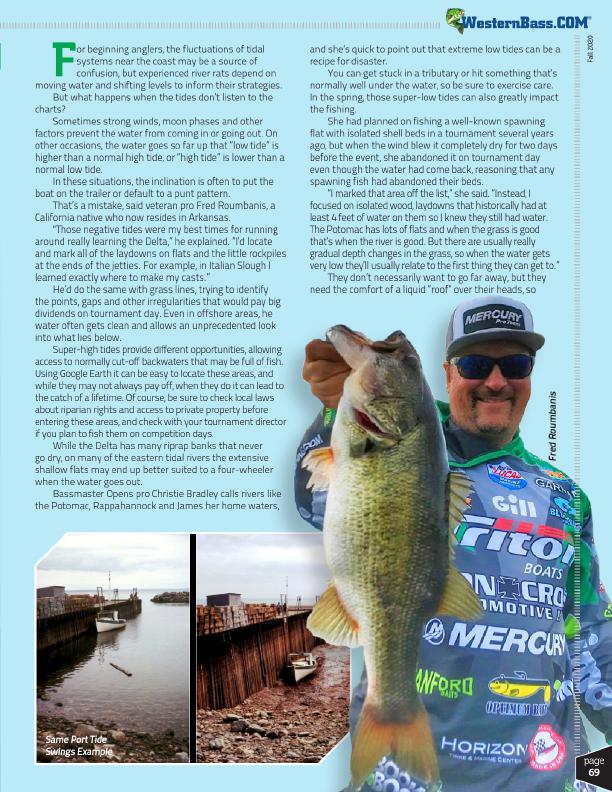
Fall 2020
F
or beginning anglers, the fluctuations of tidal
systems near the coast may be a source of
confusion, but experienced river rats depend on moving water and shifting levels to inform their strategies.
But what happens when the tides don’t listen to the
charts?
Sometimes strong winds, moon phases and other
factors prevent the water from coming in or going out. On
other occasions, the water goes so far up that “low tide” is
higher than a normal high tide, or “high tide” is lower than a
normal low tide.
In these situations, the inclination is often to put the
boat on the trailer or default to a punt pattern.
That’s a mistake, said veteran pro Fred Roumbanis, a
California native who now resides in Arkansas.
"Those negative tides were my best times for running
around really learning the Delta,” he explained. “I’d locate
and mark all of the laydowns on flats and the little rockpiles
at the ends of the jetties. For example, in Italian Slough I
learned exactly where to make my casts.”
He’d do the same with grass lines, trying to identify
the points, gaps and other irregularities that would pay big
dividends on tournament day. Even in offshore areas, he
water often gets clean and allows an unprecedented look
into what lies below.
Super-high tides provide different opportunities, allowing
access to normally cut-off backwaters that may be full of fish.
Using Google Earth it can be easy to locate these areas, and
while they may not always pay off, when they do it can lead to
the catch of a lifetime. Of course, be sure to check local laws
about riparian rights and access to private property before
entering these areas, and check with your tournament director
if you plan to fish them on competition days.
While the Delta has many riprap banks that never
go dry, on many of the eastern tidal rivers the extensive
shallow flats may end up better suited to a four-wheeler
when the water goes out.
Bassmaster Opens pro Christie Bradley calls rivers like
the Potomac, Rappahannock and James her home waters,
and she’s quick to point out that extreme low tides can be a recipe for disaster.
You can get stuck in a tributary or hit something that’s normally well under the water, so be sure to exercise care. In the spring, those super-low tides can also greatly impact the fishing.
She had planned on fishing a well-known spawning flat with isolated shell beds in a tournament several years ago, but when the wind blew it completely dry for two days before the event, she abandoned it on tournament day even though the water had come back, reasoning that any spawning fish had abandoned their beds.
“I marked that area off the list,” she said. “Instead, I focused on isolated wood, laydowns that historically had at least 4 feet of water on them so I knew they still had water. The Potomac has lots of flats and when the grass is good that’s when the river is good. But there are usually really gradual depth changes in the grass, so when the water gets very low they’ll usually relate to the first thing they can get to.”
They don’t necessarily want to go far away, but they need the comfort of a liquid “roof” over their heads, so
Fred Roumbanis
®
Same Port Tide Swings Example
they’ll often move “to the mouths of feeder creeks, close to the places they would’ve been.”
On rivers narrower than the Potomac, it’s easier and safer to find those places because the shorelines don’t typically slope so slowly. Either way, the shrunken playing field can result in even more predictability if you don’t get spun out by the circumstances.
On super-high tides, especially in the fall, Bradley looks to extensive lily pad fields, some of which normally have little water on low tide. The bass will follow baitfish moving back there, and indeed the newly flooded ecosystem presents lots of varied feeding opportunities.
She’ll make long casts with a buzzbait, covering water and often evoking explosive
page 69